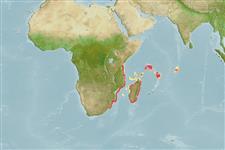Ikan bertulang rawan (sharks and rays) >
Carcharhiniformes (Ground sharks) >
Proscylliidae (Finback catsharks)
Etymology: Eridacnis: Etymology not explained, possibly eri-, Greek intensive particle (i.e., very), and dakno (Gr.), bite, referring to “wide, angular” mouth of E. radcliffei. (See ETYFish); sinuans: Latin for sinuous, probably referring to its slender body and/or long, ribbon-like caudal fin. (See ETYFish).
More on author: Smith.
Environment: milieu / climate zone / depth range / distribution range
Ekologi
laut batidemersal; kisaran kedalaman 180 - 480 m (Ref. 244). Deep-water; 4°S - 30°S
Western Indian Ocean: confined to South Africa, Mozambique and Tanzania.
Length at first maturity / Size / Weight / umur
Maturity: Lm ?, range 37 - ? cm
Max length : 37.0 cm TL (female)
deskripsi pendek
Kunci identifiaksi (pengenalan) | Morfologi | Morfometrik
Duri punggung (Keseluruhan (total)) : 0; Duri dubur: 0. A slender, dwarf catshark with 2 equal-sized dorsal fins and a long tape-like caudal fin (Ref. 5578). Grey-brown in color (Ref. 5578).
Found on the upper continental slope and outer shelf (Ref. 244). Feeds on small bony fishes, crustaceans and cephalopods (Ref. 244). Ovoviviparous (Ref. 50449), with 2 young in a litter (Ref. 244). Geographic or bathymetric segregation of populations by sex probably occurs as most specimens taken off Natal were male (Ref. 244).
Ovoviviparous, embryos feed solely on yolk (Ref. 50449). Bears two young (Ref. 5578). Size at birth between 15 and 17 cm (Ref. 244).
Compagno, L.J.V., 1984. FAO Species Catalogue. Vol. 4. Sharks of the world. An annotated and illustrated catalogue of shark species known to date. Part 2 - Carcharhiniformes. FAO Fish. Synop. 125(4/2):251-655. Rome: FAO. (Ref. 244)
Status IUCN Red List (Ref. 130435)
penggunaan manusia
Perikanan: tidak ada kepentingan
Alat, peralatan
laporan khas
muat turun XML
Sumber internet
Estimates based on models
Preferred temperature (Ref.
123201): 12.8 - 18.4, mean 15.3 °C (based on 18 cells).
Phylogenetic diversity index (Ref.
82804): PD
50 = 0.6328 [Uniqueness, from 0.5 = low to 2.0 = high].
Bayesian length-weight: a=0.00389 (0.00180 - 0.00842), b=3.12 (2.94 - 3.30), in cm total length, based on all LWR estimates for this body shape (Ref.
93245).
Trophic level (Ref.
69278): 4.2 ±0.58 se; based on food items.
Daya lenting (Ref.
120179): sangat rendah, Waktu penggandaan populasi minimum lebih dari 14 tahun (Fec=2).
Fishing Vulnerability (Ref.
59153): Low to moderate vulnerability (27 of 100).
